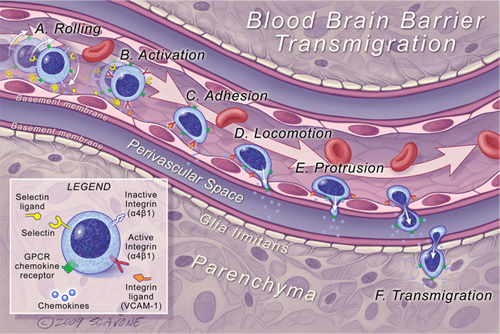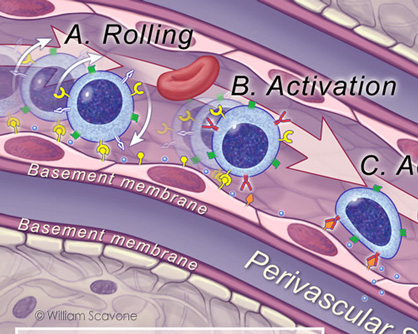Blood Brain Barrier Transmigration


Multistep recruitment of leukocytes across the blood and CSF barriers in the inflamed brain.
(A) Rolling: autoreactive leukocytes loosely tether and roll along the endothelial cells due to the binding of selectins and associated ligands. The shear forces of the blood flow continue the autoreactive leukocyte in a rolling motion while sensing activating factors.
(B) Activation: once the rolling leukocyte slows in velocity it reacts to chemokines on the endothelial surface via G-protein-coupled receptor, resulting in activation and conformational changes of integrins on the leukocyte surface.
(C) Adhesion: activation leads to an increased affinity and avidity for endothelial ligands and arrest of the leukocytes rolling motion. Only activated leukocytes are able to mediate firm adhesion.
(D) Locomotion: arrested leukocytes move across the endothelial surface until the tight junctions of the endothelium, interendothelial junctions, are identified.
(E) Protrusion: activated leukocytes extend protrusions through the tight junctions sensing chemokines that serve as guides. (F) Transmigration: diapedesis of leukocytes through the endothelial barrier between the endothelial basement membrane and the basement membrane of the glia limitans within the perivascular space. Matrix Metalloproteinases (MMPs) facilitate the leukocytes migrating both basement membranes and the glia limitans, providing entry into the parenchyma.
Joscelyn, Jennifer L. and Lloyd Kasper. "Principles of Immunotherapy." Clinical Neuroimmunology: Multiple Sclerosis and Related Disorders, Current Clinical Neurology, 2011, 15-40, DOI: 10.1007/978-1-60327-860-7_2.
This image CAN be licensed for re-use by Kestrel Illustration Studio.
How may I purchase this image for use?
